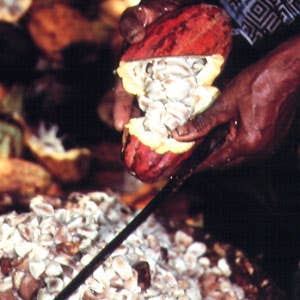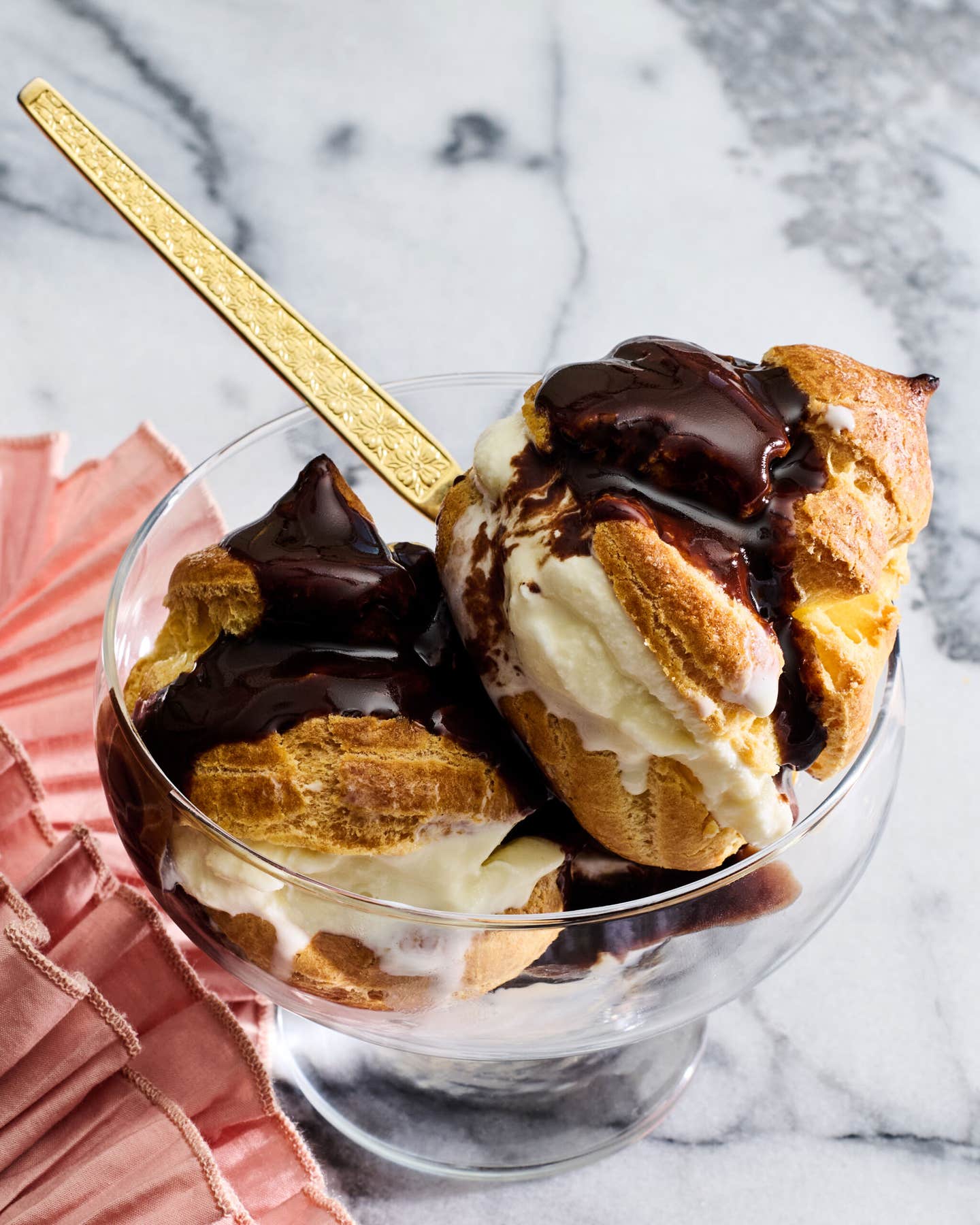
Where The Chocolate Tree Blooms
Rare criollo cacao takes a complex journey from the farms of Venezuela to the candy shops and pastry kitchens of the world.
A small woman in a light shift and slippers stands in the shade of tattered banana leaves, a furrowed, gourdlike fruit set on a stump before her. With a machete, she smacks at the fruit's woody casing smartly, cleaving it open to reveal tight rows of fleshy seeds, which resemble overblown, misaligned corn kernels. She scoops the lilac-tinged ivory mass out onto a cloth, then tosses the thick, heavy shell onto a fast-growing mountain of lilac, amber, and lime-green pods.
I sample the pod's juicy, tartly sweet pulp. Its beans are cacao, from which chocolate is made—but this pale, lumpy heap couldn't be more different from that sleek, swarthy substance. Can there really be a connection between this strange fruit and a box of elegant bonbons or a chocolate cake? I've come to Venezuela, home of some of the world's best and rarest cacao, in an attempt to find out.
Cacao is thought to have originated in Brazil's Amazon basin, but it grows today in equatorial climates all over the world. West Africa, Malaysia, and Brazil produce most of the world's cacao, with Venezuela supplying less than 1 percent.
Like wine grapes, though, cacao beans develop different characteristics in different regions. While it's hard to rate chocolate comparatively since styles vary so dramatically, it's clear that conditions in Venezuela are highly favorable for cacao. Beans grown here tend to have exceptional perfume and depth of flavor.
Three basic cacao types are cultivated in the world today: Forastero is the workhorse of the industry, a high-yielding, sturdy plant. It accounts for about 90 percent of the world's production and is the source of most commercial chocolate—though its beans lack subtlety and aroma. Criollo, native to Venezuela, is the most complex in flavor and aroma, but its trees are the most fragile. This may account for the fact that, outside of Venezuela, there have been virtually no new criollo plantings for the past 50 years, and existing criollo fields are being replaced by forastero. Criollo, along with a third variety, trinitario—a cross between criollo and forastero—now accounts for less than 10 percent of the world's cacao. (Trinitario has characteristics of each parent, including prolific, sturdy trees and flavorful beans which come close to criollo's nuances.)
The cacao trade in Venezuela, which dates from the 1500s, was once vital to the country. Exports burgeoned throughout the 17th century, and, by the beginning of the 19th century, the country was producing half the cacao in the world. With the discovery of oil in Venezuela in the early 20th century, however, cacao—like other agricultural products—lost its economic luster. Cacao plantations languished and traditional production techniques were gradually forgotten.
Between 1975 and 1991, the Venezuelan government held a monopoly on cacao, and bought beans from growers for a set price, regardless of quality. (Private companies would, in turn, buy the beans from the government.) As a result, growers grew careless, and the quality of the cacao crop declined. Even then, though, the country's criollo trees continued to produce beans superior in flavor to those of the forastero.
"Venezuelan is some of the last true 'flavor grade'—as opposed to bulk grade—cacao that can still be found," says Peter Blommer, vice president of Blommer Chocolate, the largest bulk-chocolate manufacturer in the United States. "It has peaks and valleys of taste, different flavor notes of fruit, wine, and flowers that are interesting and complex."
The restoration of high-quality Venezuelan cacao to the world market is a life mission for Jorge Redmond Schlageter, a third-generation Venezuelan and the president of Chocolates El Rey, a major Venezuelan chocolate producer. Redmond's company is working with farms to develop cultivation programs for criollo and trinitario beans, and to revive time-honored curing techniques that were ignored during Venezuela's period of economic and political uncertainty, which ended only in the late 1980s.
Redmond, an imposing but soft-spoken and genial gentleman with old-world graces, has offered to guide me on a farm-to-factory tour of the Venezuelan cacao industry. We begin with a dusty ride along twisting roads through the Paria Peninsula in Sucre state, a spit of land that pokes out into the Caribbean and nearly touches Trinidad. Here, you learn to brake for beans: Little carpets of almondlike seeds, the yield of small land holdings, are spread to dry in the middle of the road, as well as on porches and sidewalks, wherever it's sunny and dry. (The country's 17,000 growers tend to fill their small land plots, generally about 12 acres each, with trees, leaving little space for drying beans.)
Steep hillsides seem to grow wild with patches of tangled trees. The patches are, in fact, scattered working farms—banana and plantain trees planted side by side with cacao trees to shield them from direct sunlight. Large tropical shade trees grow nearby, further protecting the cacao. On crests, scarlet flame trees blaze in the sun, the sole vivid color in this dry-season landscape.
We pull up to the Hacienda Agua Santa, one of Venezuela's few remaining large colonial-era plantations. This 300-acre property had been ignored for two decades, but is now being revitalized by its owners. Fortunately, the trees are resilient: Even after years of neglect, they are still healthy.
Cacao trees generally hit their stride in their eighth year, and bear fruit steadily for up to 30 or 35 years more. Walking through the disheveled groves, a blanket of dried leaves crackling beneath my feet, I also discover that they flower, fruit, and mature continuously. They are cauliflorous plants, meaning that their blossoms and fruit jut directly from the trunk and larger branches. Laden with pods of varying shapes and sizes, the trees seem mammalian, their ponderous burdens ornaments of fertility. Peering closely through glossy, garnet-tinged leaves, I find tiny pastel buds attached to the slender, lichen-clad trunk. They open to waxy, orchidlike blooms.
The farm's team of harvesters splits open freshly picked pods with machetes and spreads out the pulp onto wooden flats, where it will sit in the sun until the beans are dry enough to be stored for later roasting. The exposed beans smell vinegary, the result of the spontaneous fermentation that begins when the pulp and beans come into contact with the air.
Haphazard fermentation, like that at the Hacienda Agua Santa, produces a chocolate with a somewhat short flavor and a muddy aftertaste. But Redmond, who buys some of his beans here, is urging the owners to improve their fermentation methods, and he has high hopes for the estate.
"When you ferment methodically, instead of in haphazard fashion," says Redmond, "cacao explodes with flavor." Methodical fermentation is evident at the nearby Hacienda San Jose, our next stop along our cacao route. Here, brothers Jose Vicente and Juan de Dios Franceschi, fourth-generation cacao farmers, understand the importance of the process. Though their crops, too, had been neglected until recently, the Franceschis have invested in new trees and equipment, and now use both time-honored and modern techniques.
They keep freshly harvested pods whole for at least five days before they're split open. This technique, recently developed in Malaysia, primes the beans for fermentation, and encourages flavor development. When the pods are finally opened, the pulp and beans are heaped into wooden boxes and covered with plastic sheets to promote even fermentation. (Banana leaves were used traditionally.) Fermentation lasts three to seven days, depending on the type of bean; then the cacao is dried in the sun and stored for later sale.
We drive to a small airport, hop aboard a tiny plane, and head for Redmond's experimental farm on the flat plains of Barinas state, for a glimpse of Venezuela's cacao-growing future. As we land, los llanos (the plains) appear—the veldtlike cattle land that stretches across one-third of the country. We climb aboard a truck that carries us along bumpy roads, through the Venezuelan outback, to the 2,950-acre Finca San Joaquin.
Here, researchers hope to create more disease-resistant and more productive hybrids that will produce richly flavored beans. Success here could serve as an example for other growers. "We can start a production program to develop potential in this part of the country," explains agronomist Beatriz Escobar, a warm, handsome powerhouse who is as notable for her leadership in Latin cowboy country as she is for her expertise and commitment to the estate. Soil conditions are sound here, she says, and the plants do well without their usual shade trees. A 344-foot well and a powerful irrigation system counter the annual four-month drought—from January through April.
Escobar points to rows of hot, straggling trees, kneels, and pats some fat baby pods. "The average yield in the country is less than 450 pounds for each hectare [about two and a half acres]," she says. "We expect a minimum of 3,300." She slaps the trunk as if it were a horse's flank, settles a shocking-pink straw hat on her blackbird hair, leaps a ditch, then bounds off.
"If this works," says Redmond dreamily, "Barinas will be a living laboratory for cacao cultivation. We'll set up farms in other key areas to ensure supplies throughout the country and at last restore cacao to its rightful place." He laughs and adds, "If Beatriz can't make it work, nobody can!"
A 30-minute flight in our trusty Cessna zips us from the heat-struck outback to the icy, stainless-steel technology of Chocolates El Rey's factory in Barquisimeto, one of Venezuela's fastest-growing cities. For nearly 400 years, Venezuelans sent most of their cacao to Europe for processing. In 1995, El Rey became the first Venezuelan firm to export its own premium chocolate.
At the factory, with few exceptions, the cacao route runs through polished steel. Dried beans are mechanically cleaned, then briefly roasted at low heat to enhance their natural flavors. As the nib, or meat, dries and contracts, the shell cracks and is blown away. The nibs are fed into mills and ground into a viscous paste called chocolate liquor, destined to become either cocoa powder or eating chocolate. Cocoa powder is made by pumping the liquor into hydraulic presses that extract cocoa butter, leaving a cake that is pulverized to a powder and sifted.
For eating chocolate, supplementary cocoa butter and sugar (and sometimes flavorings and powdered milk) are added to the chocolate liquor. The molten mass is then conched, or kneaded—a method that can last from several hours to several days.
As I witness this part of the process, amid pulsing machinery, gliding cylinders, and flickering digital displays, I catch sight of glossy, unctuous pools of dense, dark brown liquid. I finally see cacao becoming the chocolate I know.
Just before it's molded, the chocolate is tempered, a step in which the temperature is raised and lowered, to give it sheen and smooth texture. The chocolate is then piped into molds that travel on a conveyor belt through a cooling tunnel, and are then flipped onto little pallets. Finally, the chocolate is unmolded, and the glossy blocks proceed to the packing area, where they are colorfully wrapped for sale.
Tucking a sample of just-made chocolate into my pocket to savor later, I find a handful of beans I'd stuck there earlier. It's still hard to believe that the one produced the other. But when I taste the chocolate—which started out as a lumpy mass of beans and was then transformed through fermentation, roasting, grinding, conching, molding—I find in it the subtle tastes of coffee, spice, nuts, and earth; a distinct gout de terroir; the flavor of its source.
Keep Reading
Continue to Next Story










